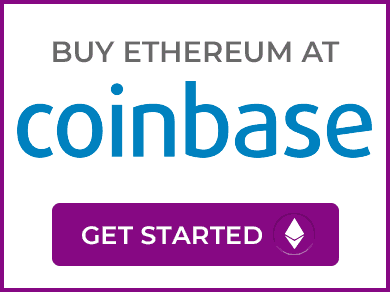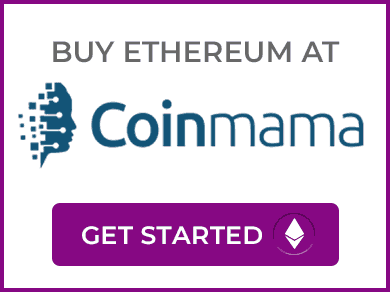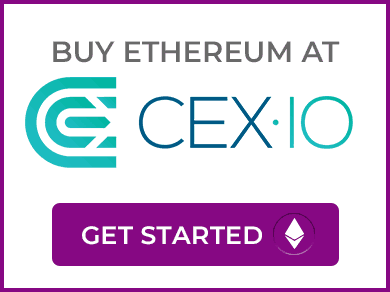ETHEREUM – COIN REVIEW
Mix in the altruistic vision behind Google’s early “Do no evil” mantra, the foresight and vision of Steve Jobs and add in a dash of economic social engineering and you’ve got Ethereum, the platform that will potentially power the applications we use everyday and redefine what we think of as the ‘internet’.
ETHEREUM COIN REVIEW
Pros
- Potential to be the platform for next generation distributed apps (dApps)
- Well established development community
- Planned to move to Proof of Stake to reduce energy usage of validation
Cons
- Very large scalability challenge
- History of problems in some high profile smart contracts/dApps
- Many competitors with potential to overtake platform
A DISCLAIMER FOR THE UNINITIATED
Even though crypto technology and the ecosystem around new cryptoassets can be complicated, Ethereum takes complicated to the next level. To the uninitiated, trying to first understand Ethereum is extremely challenging.
Starting with the somewhat philosophical and obtuse whitepapers, Medium articles or tweets of its founder and chief evangelist, Vitalik Buterin, and trying to make sense of the quirky vernacular used like gaslimit, uncle, sharding, Casper, GHOST and others make it seem like the folks behind Ethereum are over-complicating things. But (and it’s a big but), if the stated goals and ambitions of Ethereum can be achieved, the platform truly does have the potential to be the foundational layer upon which the next generation of applications are built.
WHAT IS ETHEREUM?
So what is Ethereum and what are the concepts it is based upon? Is it a platform, a cryptocurrency, a programming language, an entirely new economic system or a philosophy? The answer is that it is all the above.
Ethereum is a blockchain-based platform that uses a cryptocurrency, Ether (ETH), to act as a unit of value used in it’s own complete programming languages, Solidity and Ethereum Virtual Machine code (EVM), to empower ‘smart contracts’ or Distributed Applications (dApps).
These dApps can have their own tokens or coins each with independent values and properties. All of this is designed to ensure decentralization, security and fairness.
What Ethereum has done is take all the properties of Bitcoin and built a nearly full-fledged language ON TOP that allows for those with the know-how to create applications and other currencies. When you hear about Initial Coin Offerings (ICOs) being the newest way for startups to raise money, many of those are based off of the Ethereum platform.
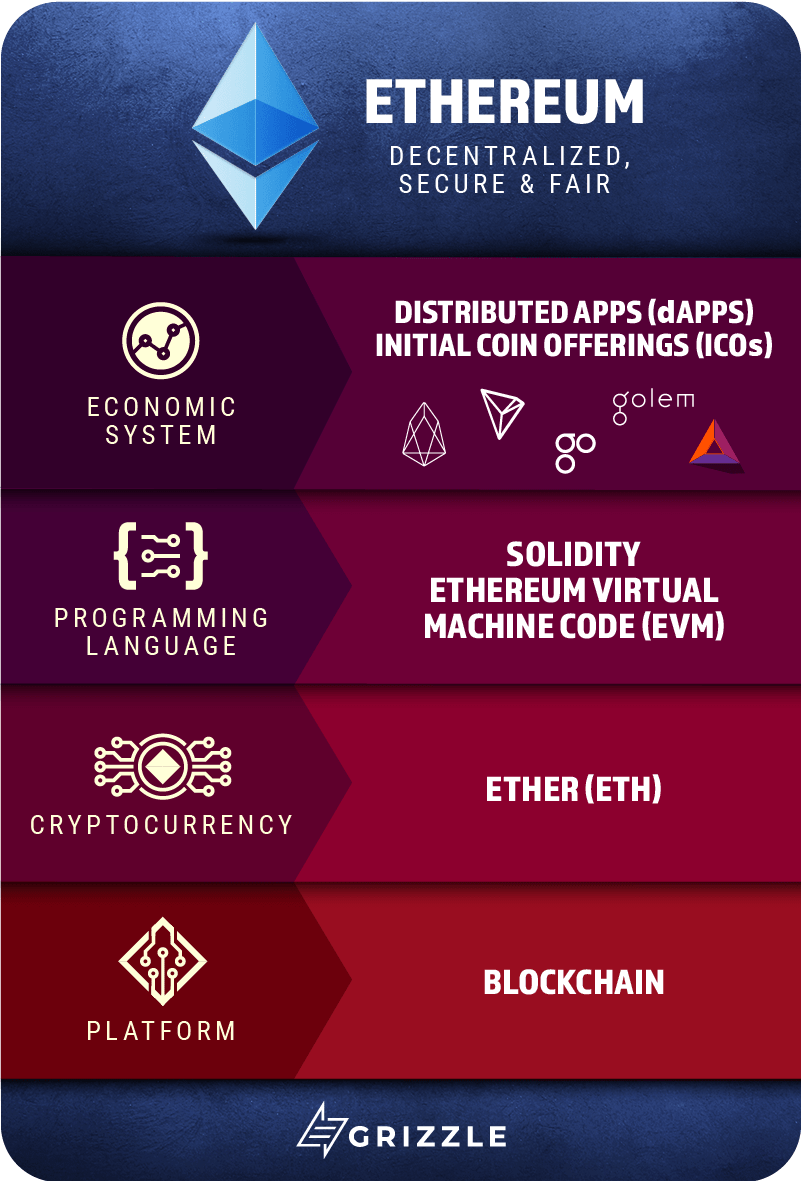
THE PLATFORM OF THE FUTURE?
Where things really get interesting (and again complicated, unfortunately) is how Ethereum is setting about becoming the platform of the future. Ethereum, like Bitcoin, has challenges around its scalability and these problems are even more acute in the case of Ethereum since it needs to support the transactions for all of the dApps and their tokens as well as ETH transactions.
Ethereum also faces the same concerns as Bitcoin over the impact that the cryptoasset has in terms of the energy required for mining, which is the primary means of validating transactions. However, unlike Bitcoin, the Ethereum development community is guided in a more cohesive direction towards solutions to those problems. Ethereum’s community acknowledges the problems openly and has been at work conceptualizing solutions that will enable a much more sustainable, scalable version of the platform.
DEVELOPMENT TEAM
The story of Ethereum begins with Vitalik Buterin when he published the Ethereum whitepaper in late 2013, which built on top of many of the concepts from Satoshi’s Bitcoin whitepaper.
The goal was to take the fundamental aspects of the blockchain that Satoshi pioneered and to add in a programming language that would allow many more systems to be built using the technology. The leadership and sometimes cult-like following that Vitalik Buterin inspires have led many to believe that he is the one who will shepherd blockchain technology into the future. But Vitalik, considered to perhaps be the guiding force and conscience of Ethereum, is supported by a dedicated community of open source developers.
Other prominent contributors to Ethereum, such as Vlad Zamfir have even been handed the reins on extremely important projects for Ethereum (more on this in the Underlying Technology section later).
Ethereum Development
Ethereum development is split among several different Ethereum clients (a client is the means for users to interact with the Ethereum network in different operating environments), with some being developed by private companies such as Parity. But the main client, go-ethereum, maintained and developed by the Ethereum Foundation, a not-for-profit organization that supports the platform and its development, is the one that sets the standards.
When looking at the development of this main Ethereum client, it is interesting to note that activity recently seems to have plateaued. However, when adding up the ongoing work happening on several other important projects contributing to Ethereum to see the work in totality, the Ethereum development teams are clearly working towards building for the future.
ETHEREUM GITHUB COMMITS
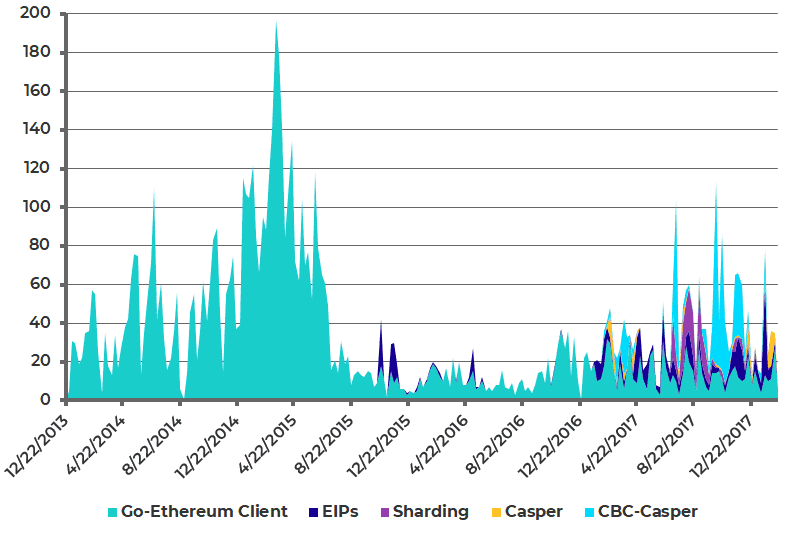
Data Source: Github
Devcon
Ethereum developers get together to share research and development at an annual conference aptly titled Devcon, sponsored by the Ethereum Foundation. The conference has grown as rapidly as the platform, starting out with just 50 devoted attendees in 2014 at Devcon0 to 2,000 at last year’s Devcon3 in Cancun.
Although perhaps emblematic of the overall growth in the interest in cryptocurrencies in general, it is worth noting that the Ethereum Foundation had to scale up the event several times to accommodate the demand.
Covering 4 days and 147 sessions, the topics discussed by the development community covered a wide range of topics but perhaps most importantly, Vitalik, the ever-fearless leader laid out his vision for Ethereum over the next several years.
Conclusion: Development Team
One challenge Ethereum and all blockchain systems have is to implement large structural changes, since it can be a political process to convince the larger ecosystem to adopt those changes through a hard fork.
However, Vitalik and Ethereum have also found a solution to allow them to develop, test and mature many ambitious complicated aspects of the vision WITHOUT requiring a hard fork.
Ethereum developers clearly get that even if they have innovative solutions to fixing the problems, there is an inherent value to maintaining the status quo while those solutions are gradually incorporated. The balance between open development and controlled changes to the already large system in place is yet another innovation that Ethereum has figured out.
COIN SUPPLY
When Ethereum was first publicly announced at the Bitcoin conference in Miami in January 2014, the system and the coin were still being developed. By July of that year Ethereum launched its presale of the ETH coin. That presale helped the Ethereum Foundation raise over $18 million and established a total supply of ETH when the network launched in July of 2015 of 72 million ETH (60 million to subscribers of the presale and 12 million to the Ethereum Foundation).
Instead of limiting the total amount of ETH that can ever exist, Ethereum has a slightly different mechanism of controlling inflation of ETH. Ethereum limits the number of coins that can be created each year to 18 million ETH (25% of the initial supply).
The rationale behind this design decision was that the RELATIVE inflation of ETH would continue to decrease over time AND because the permanent loss of ETH (or any cryptocurrency for that matter) can happen due to the loss of a private key, that the new supply and the loss of supply in the long-term would balance out to reach an equilibrium.
Proof of Work
ETH is currently created using a Proof of Work (PoW) algorithm like Bitcoin with slightly different properties that allow a quicker block time (~15 seconds compared to ~10 minutes) and different cryptographic properties, which provides more fairness by allowing validation (ensuring the correctness of transactions) to be done on less specialized equipment.
However, like many other aspects of Ethereum, the dynamics of the coin supply are planned to change significantly in the near- to mid-term. The energy usage and risk of centralization involved in a PoW system was a concern that Vitalik and others involved in Ethereum identified early on as an area where Ethereum could improve on Bitcoin.
Proof of Stake
What they committed to was a different type of validation method called Proof of Stake (PoS). Instead of doing ‘work’ to ensure the correctness of transactions, validators in PoS ‘stake’ coins that they own by putting them into a virtual lockup to be used for validating a block. Then the next block is ‘forged’ (the term used for mined in PoS systems) when there is a consensus reached among validators. At this point, all validators who chose the correct block (i.e. didn’t act maliciously), will share the block reward and transaction fees proportionally based on the amount each validator has staked.
Part of the Ethereum roadmap and development all along has been to move to a PoS means of validation. Once this transition occurs the dynamics of the Ethereum coin supply will change. Although the specifics are still being worked out, what has been committed is that the number of ETH generated will not be more than the current maximum (18 million/year) and will likely be much less.
Casper
The first phase of Ethereum’s transition to PoS, Casper Friendly Finality Gadget (FFG) introduces a PoS validation every 50 blocks with the blocks in between validated using the existing PoW system. FFG is planned to begin in mid to late 2018.
The second phase will likely be a combination of FFG and another branch of research in Ethereum called Casper Correct by Construction (CBC). Casper CBC research explores basic principles of how nodes in a network can ensure that they agree on a result (consensus), principally in this case to agree that transactions on the Ethereum blockchain are valid.
Conclusion: Coin Supply
As the work towards transitioning Ethereum to a proof-of-stake protocol continues and the changes are deployed, close attention should be paid to how the availability of ETH impacts the price. Many believe that the impact of the changes are already incorporated into the price. These changes are also expected to reduce the trading supply of ETH since there will be less ETH created, which could lead to pent up demand from larger institutional investors thereby increasing the price in this supply-constrained environment.
COIN VALUE LINKED TO SUCCESS OF BLOCKCHAIN PLATFORM
ETH, the native coin in the Ethereum platform, is used to provide ‘fuel’ for all the smart contracts and dApps that run on the Ethereum network. In addition to transactions that can transfer value in ETH between two account holders, every transaction on Ethereum has two properties, which together define how to calculate the transaction fee in ETH required to perform the transaction.
Calculating Ethereum transaction fees
Start gas – (sometimes referred to as “gas limit”) defines the maximum number of computational steps that the transaction can perform
Gasprice – defines the price in ETH per computation of the transaction
Total transaction fee = the lesser of the (# of computational steps * gasprice) OR the (startgas * gasprice)
Explanation – Transactions (including the code for the contract within them) can continue to run until they get to the destination (complete all the execution steps in the code) or they run out of gas (take more computational steps/data than the limit).
Together, these properties ensure that the fees for each transaction are proportional to the load that the transaction puts on the network. This encourages legitimate users to write transaction code that is well formed and causes malicious users to be dissuaded from bringing down the network by flooding it with transactions as in a Denial of Service (DoS) attack.
Since Ethereum transactions are intended to facilitate other applications, the fact that transaction fees are proportional to the load on the network will promote efficient use of the network by the participants and will provide the economic incentives for validators to join the network and grow capacity as more applications are added. These built in mechanisms in the Ethereum network will promote stability and efficiency, thereby increasing the long-term value of ETH.
STRENGTH OF THE COIN ECOSYSTEM/BLOCKCHAIN
The Ethereum ecosystem involves many different moving parts due to the nature of its use as a platform for other applications as well as the many areas of development being pursued for the network.
The base layers of the Ethereum protocol and the code it can support on the blockchain allow for smart contracts and dApps. Meaning developers can build applications that replace all kinds of financial or legal transactions as well as more generic applications, such as ones that can transform whole industries or games to collect and trade digital cat collectibles.
The possibilities aren’t endless as there are some types of applications that aren’t suitable for decentralization like ones that require a lot of serial computations (e.g. cloud computing). But there are many applications that can be decentralized effectively and provide utility to users.
ICOs
On top of allowing developers to build applications for this new decentralized internet, Ethereum went a step further in 2015 by introducing a standard for creating tokens in Ethereum, thereby allowing developers or any company for that matter to raise money. These token offerings have come to be known as Initial Coin Offerings (ICOs) and have become a very popular means to raise funds.
But like any fundraising opportunities for new technology or companies, not all ICOs are created equal and there have been several ICOs that amounted to no more than a scam or a get rich quick scheme. The Ethereum community in general have left determining the merits of a given ICO up to individual investors.
Although there are those in the Ethereum community who believe ICOs are the future, there are impacts to regular ETH usage because they add to the load on the network and cause longer transaction times and higher fees. So, some in the community hope that the market matures to understand that token offerings only make sense for applications that can take advantage of Ethereum’s decentralized platform.
Although ICOs may be a utility that Ethereum can provide and there was $3.7 billion dollars raised in 2017 and many ICOs planned for 2018, watching how successful they are and how much their network usage will be is important as progress towards scalability continues.
Attacks on Ethereum Applications
In addition to Ethereum being used to fund questionable token sales, there have also been several high-profile attacks on Ethereum applications and clients. The most important attack so far in the history of Ethereum is known as the ‘DAO attack’.
DAO stands for Decentralized Autonomous Organization and represents a smart contract that encodes all the rules of a company or organization, which is governed purely by the code in that smart contract without human interference.
‘The DAO’, a particular implementation of a DAO, raised the equivalent of $150 million in ETH through a token offering in May 2016 and ended up holding up to 16% of all ETH in existence at the time. But due to a simple coding mistake, the DAO was attacked by a malicious user who was able to siphon off $50 million worth of ETH into a child account.
The mistake was in the code of the smart contract for ‘The DAO’, not Ethereum, but the fact that such a simple mistake could raise such serious consequences called into question the overall security/efficacy of Solidity, the Ethereum coding language. As the investigation continued, it became clear that the community faced a critical decision point:
- Do the seemingly ‘right’ thing and take the ETH back from the attacker to make the DAO investors whole again by performing a hard fork (creating a new version of Ethereum that would not be backwards compatible)
- Stay true to one of the guiding principles in crypto and do not change history; let the attacker keep the funds and leave the incident as a cautionary tale to investors in future smart contracts that more due diligence needs to be performed on the code underlying the smart contract
After a lively debate and a community vote, the choice was to return the funds to the DAO investors by performing a hard fork, which happened on July 20, 2016. The new chain created by the fork was widely adopted but there was still some who supported the original chain and what became known as Ethereum Classic was born, but that is a story unto itself.
Vulnerabilities and Mistakes
The other very interesting incident that colours Ethereum’s history occurred more recently in November 2017. Yet another coding mistake, this time in Parity, one of the privately developed Ethereum clients (the interface to interact with the Ethereum network), allowed a user to take actions that caused over 500,000 ether (worth around $150 million USD at the time) to be trapped.
After a similar vulnerability was exploited in July 2017 where a malicious user stole 150,000 ETH (worth around $30 million USD at the time) a patch was made, but unfortunately an apparently novice user who was researching that July exploit “accidentally” removed the library code in Parity making all of the ETH in that library completely inaccessible.
Some of the interactions with the user who caused this issue led to the belief that they were oblivious to the consequences of their actions. This again calls into question how easy it is for a coding mistake to cause huge impacts to the Ethereum community. The ETH lost in this incident are still inaccessible and at this point it appears that the only solution to recover the funds would be another hard fork and once again reversing history.
Conclusion: Strength of the Coin Ecosystem/Blockchain
How the Ethereum community handles the recovery or non-recovery of the affected Parity users will be telling into how much influence different parts of the community have in Ethereum development.
Thus far the primary stakeholders in Ethereum seem to be resisting the temptation of standardizing a means of recovery of lost or stolen funds and taking the position that cases like the DAO are the exceptional circumstances that required extreme measures.
The Ethereum blockchain itself has not been successfully attacked, but since so many other applications sit on top of Ethereum, the security of each the dApps can also significantly affect the value of the platform itself. Ethereum faces a slippery slope in both directions when such poorly designed applications are exploited. If a solution or a mechanism to determine when/how to handle these exploits is defined it would provide holders of ETH more assurance of the value of the platform.
UNDERLYING TECHNOLOGY/FUTURE PROOF
The technology behind Ethereum may have been an evolution of the technology behind Bitcoin adding the flexibility of smart contracts, but there are many new entrants in the blockchain space working to supplant Ethereum’s smart contract and distributed application technology.
Ethereum has a huge amount of ground to make up from the current 10-15 transactions/second to be able to support up to the hundreds of thousands or millions of transactions per second that the many dApps on the network will need if they are to be widely adopted.
Key members of the community acknowledge that there's still a long way to go for Ethereum technology before it's ready to be the platform for mainstream usage and to stay competitive there has been a concentrated effort in the Ethereum community on three main fronts.
3 Areas Ethereum Needs to Improve Upon
- Scaling solutions to improve the efficiency (transaction rate) of on-chain contracts and transactions as well as off-chain solutions to support the anticipated demand as usage grows
- Moving from Proof of Work to Proof of Stake consensus to improve the efficiency (energy usage) and decentralization of the network
- Improvements in the privacy and security of the Ethereum network and transactions on the network
Scaling Solutions
Scaling solutions are explored in more depth in the section below. However, it is important to note that Ethereum has a huge amount of ground to make up from the current 10-15 transactions/second to be able to support up to the hundreds of thousands or millions of transactions per second that the many dApps on the network will need if they are to be widely adopted.
Moving from Proof of Work to Proof of Stake
Even as the main Ethereum network was being developed and work was being done to get it up and running, the interest in evolving from the Proof-of-Work model of consensus patterned after Bitcoin to a Proof-of-Stake consensus was being actively considered.
Moving to Proof of Stake was so important that in 2015 the developers incorporated a change to the Proof of Work algorithm that increased the difficulty of mining ETH exponentially over time. (Recall that mining ETH through Proof of Work is needed to validate the transactions on the blockchain and make sure they are legitimate).
The adjustment to mining difficulty is referred to as the difficulty time bomb and introduced what some refer to as the Ethereum Ice Age. It will eventually make it unfeasible to mine ETH using Proof of Work, which means that the network would be unusable since no transactions could be validated. The goal of this seemingly counter-intuitive change is twofold:
- It provides a deadline for the entire Ethereum community (developers/miners/users/ICOs) to work towards the switch to Casper, Ethereum’s Proof-of-Stake solution
- It aims to reduce the likelihood that the mining community or other parts of the community continue to utilize the PoW fork of Ethereum after the switch to PoS is made, since PoW will become very expensive very quickly

Source: Karl Floersch
Although the increase in difficulty was delayed along with a decrease to the mining block reward due to delays in the development of Casper, the fact that it still exists shows Ethereum’s commitment to future-proofing the platform.
Privacy
Privacy is a fundamental principle that blockchain technology traditionally supports, but the nature of a public open source blockchain is that the transactions on chain are typically pseudonymous instead of anonymous.
The distinction comes down to the fact that transactions can be traced back to the public wallet address sending or receiving the transaction. Several companies have built businesses around analyzing blockchain transactions to identify illicit activities or help catch tax cheaters.
Ethereum is a platform where parties engaging in smart contracts may desire privacy for the transactions within the contract that may be part of a business dealing, even if the final settlement or existence of the contract is public knowledge.
Zcash and Zero Knowledge Proofs
During it’s last major update in the fall of 2017, Ethereum introduced the ability to include technology from another cryptocurrency known for privacy, Zcash, into Ethereum, allowing for zero knowledge proofs of transactions within smart contracts.
Zero knowledge proofs are a means of letting one side (the prover) definitively confirm to another (the verifier) that a statement is true without divulging any additional details. This means it is now possible to create a smart contract in Ethereum using a generalized application of zero knowledge proofs called Zk-Snarks (Zero-Knowledge Succinct Non-Interactive Argument of Knowledge).
Although Zk-Snarks allow the contents of smart contracts to be hidden, but still verifiably correct, this added privacy requires more resources, which in Ethereum leads to higher transaction costs. Therefore, their utility may be limited to certain applications.
Ring Signatures
Another area of privacy development in Ethereum involves Ring Signatures, which is technology also used by another cryptoasset, Monero. Although not quite as strong of a privacy solution as Zk-Snarks, Ring Signatures are a cryptographic solution that would require less transaction costs and would allow a user to sign a transaction within a group of users in such a way that it isn’t possible to identify which user in the group was the signee. This technology was being tested in Ethereum’s test network by way of creating a token within a smart contract.
Conclusion: Underlying Technology /Future Proof
While Ethereum may ‘‘have no features", it’s clear that the power of having programmable smart contracts and dApps has allowed solutions to be built on top of the core platform and is paving the way to transition to the more sustainable Proof-of-Stake model and the other privacy focused innovations.
Ethereum has shown that it is focused on developments that will address the biggest criticisms of the platform. To continue its development, Ethereum needs to pursue more improvements to mature the underlying core of the network, enabling further developments on top.
ADDRESSABLE MARKET
It would be easy to get caught up in the hyperbole of some of the most ardent fanboys of Ethereum and characterize the market for the platform as anything and everything. While the concept of providing a decentralized platform with the ability to layer contracts and applications on top is extremely powerful there are some use cases that truly are more efficient on centralized platforms.
Why you don't want a blockchain -
1. Storage: Everyone has to store everything
2. Bandwidth: Everything has to be broadcast to everyone
3. CPU: Everyone has to validate everything
4. Development: Everything is 10x harder
5. Control: Everyone collectively has control, not you— Jimmy Song (송재준) (@jimmysong) February 15, 2018
That being said, there are many different use cases where distributed computing along with a decentralized platform that doesn’t rely on a trusted authority makes a lot of sense.
Starting with financial applications where rules exist around exchanging of value (loans, crowdfunding, escrow, gambling), to applications for validating identity and reputation (content ownership, skill validation), all the way to fully encoded rules for operating entities (prediction platforms, resource sharing, multiplayer games) there are many applications that can and do use Ethereum as a base layer platform.
Ethereum acts on a higher level than a store of value; it provides a fundamental platform for many different types of applications, some of which we still haven’t conceived of.
Providing users with a means that ensures certainty in the set of rules and eliminates the need for trusting application developers or contract authors is a double-edged sword. As was exemplified with the situation of the DAO and again with Parity, mistakes or vulnerabilities of those rules can have potentially serious implications on the users.
In today’s world there is a concerted effort on the part of malicious users to identify and exploit flaws in the coding of any application. But like the advent of spam filters and email authentication protocols that protect users from email vulnerabilities, over time as any technology platform scales and matures, protections are built to ensure users’ safety. So we expect standards and protections to be implemented in Ethereum to prevent shoddy coding of Ethereum smart contracts from being vulnerable to malicious users as the entire ecosystem matures.
For some of these emerging distributed applications suited to blockchain technology there will be a question whether it would be better to take advantage of the existing Ethereum network and infrastructure or to craft a unique blockchain tailored to their particular application. Although efficiencies can be gained by creating a tailored blockchain for certain applications, just like the operating systems that run our computers and mobile phones, Ethereum is currently best positioned to be the platform on which the next generation of applications are built.
It is difficult to quantify the potential market that Ethereum could address as the scope of its potential is so broad. What can be said is that Ethereum acts on a higher level than a store of value; it provides a fundamental platform for many different types of applications, some of which we still haven’t conceived of.
Although there are several other blockchain competitors that aim to compete on building the distributed computing platform of the future, Ethereum has a head start in the maturity of the technology and the reach of the current network.
PUBLIC INTEREST
The interest in Ethereum is definitely correlated to that of Bitcoin. Since its market cap currently sits as second among cryptoassets it tends to be what most looking into the space start reading about after Bitcoin.
Interest in Ethereum has reached several peaks, most notably during the DAO attack in June of 2017 and again in December 2017 when all cryptoassets gained attention due to the large price appreciations at the time.
Further to that most observers and insiders would tend to agree that Ethereum is well positioned to draw public interest due to the large interest of the development community into the platform. Not only through developers choosing to use ICOs based on Ethereum tokens (i.e. to invest in the ICO the public needs to invest in ETH) but also through a few popular dApps, which have gotten mainstream coverage. CryptoKitties is the most popular of the dApps that gathered mainstream news attention due to the huge amount of money invested in the collectibles platform for something so seemingly trivial. This interest in even the most simple of dApps goes to show the potential of Ethereum to draw public attention as other applications are built off of the platform.
SCALABILITY
There are several different scaling solutions being pursued to enable Ethereum to cope with the anticipated load that the many applications and smart contracts will put on the network. These can broadly be broken down into two categories:
- On-chain solutions to improve the efficiency of the nodes on the network and allow more transactions to be processed faster
- Off-chain solutions to reduce the number of transactions that need to be processed by the nodes on the network
On-chain Scaling Solutions
The primary work being done for on-chain scaling solutions is around the concept of sharding. Sharding is a technique used in databases to split up the processing of transactions into partitions (shard) each of which processes their own transactions and maintains the history of state. This helps improve scalabilty overall since nodes in the network are only responsible for certain shards and so have fewer transactions to process, leading to higher throughput.
At the most recent developers conference, a plan was outlined to enable sharding and the first steps towards Proof of Stake in Ethereum without a hard fork through the Validator Manager Contract (VMC). This will allow the benefits of the solution to be validated on the main network without any forced adoption by miners or those who run the full nodes and help to mature the improvements that much faster.
Off-chain Scaling Solutions
The other category of scaling solutions for Ethereum are similar to those being pursued by other cryptocurrencies. Raiden, is an example of a project to create off chain payment channels (i.e. direct peer-to-peer network separate from the main Ethereum blockchain), but there is also the concept of state-channels to allow multi-step transactions to move off chain then have the final state be settled on the main network.
Other solutions for scaling off-chain include Plasma, an intermediary layer between Ethereum and Raiden and/or state channels to allow for smart contracts to be handled off chain; Polkadot, a framework designed by one of Ethereum’s co-founders to allow for interoperability between many different blockchains; and TrueBit, a solution to allow complex computations in smart contracts to be performed off chain.
Conclusion: Scaling
Scaling effectively is critical for Ethereum’s success, otherwise the next CryptoKitties or hot ICO will bring high transaction fees and slow confirmation times. Given the level of extremely smart and motivated people working on the above projects it seems clear that all invested in the ecosystem realize that fact.
As noted there is a huge gap to make up, however, and all the above solutions or similar ones to come will be required to support the decentralized platform for the applications of the future.
PROMINENT INVESTORS/BACKERS
In addition to the devoted developer community that follows and believes in Ethereum, the platform has drawn the interest of many others who hope to explore its potential.
A large group of organizations, including blue-chip companies like Microsoft, Intel, JP Morgan and UBS joined to form the Enterprise Ethereum Alliance to promote enterprise use of the Ethereum blockchain and establish a resource for businesses to learn about the technology.
There are also investment interests gathering around the Ethereum platform such as Ethereum Capital, which announced earlier this year it would raise $50 million to invest in Ethereum-related businesses.
More recently, a new Ethereum Community Fund (ECF) joined together several prominent ICOs and support from Vitalik himself to create a fund that plans to pay out over $100 million to help jumpstart Ethereum projects. The ECF is a prime example of just how willing those who believe Ethereum are putting their money where their mouth is. The more people seem to learn about the platform, leadership and concepts behind Ethereum, the more invested they become.
LIQUIDITY AND VOLATILITY
Ethereum may currently have the second highest market capitalization among other cryptoassets, but it’s liquidity is somewhat lagging. This could be partially because a portion of ETH is locked up in smart contracts and isn’t being transacted daily. The average 24-hour dollar value traded volume for the last 30 days for ETH was $3.6B, relative to the average market capitalization over the same period of $93.8B, implying 3.8% of the float is traded daily.
Cryptocurrencies are inherently highly volatile investments (new market, coupled with small market capitalizations). The lower the relative price volatility the better (less shaky hands are holding the asset). Ethereum has the second lowest 90-day average daily price volatility among the top 10 cryptocurrencies, at 145% (annualized figure).
TOTAL SCORE
Ethereum still has a lot of work ahead of it to take the solutions from concepts to reality and for sure there will be more bumps along the way. However, it is our opinion that the momentum and foresight that has guided the entire Ethereum project since its inception will continue to keep it ahead of the pack of other competitors with distributed application blockchain technology.
Despite it’s relatively large market capitalization, Ethereum has even more potential gains ahead of it as more smart applications are built on top of it, which only means that the value of ETH will continue to appreciate and has more potential upside than other crypto holdings in a diversified digital asset portfolio.
Users should be aware that if they click on a cryptocurrency link and sign up for a product or service, we will be paid a referral fee. This in no way affects our recommendations, which products we choose to review or our advice which is the sole opinion of the authors.
The opinions provided in this article are those of the author and do not constitute investment advice. Readers should assume that the author and/or employees of Grizzle hold positions in the company or companies mentioned in the article. For more information, please see our Content Disclaimer.

